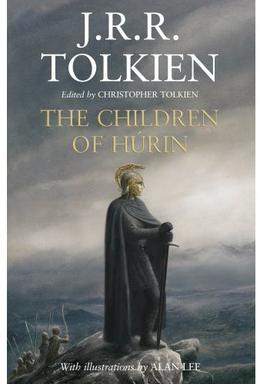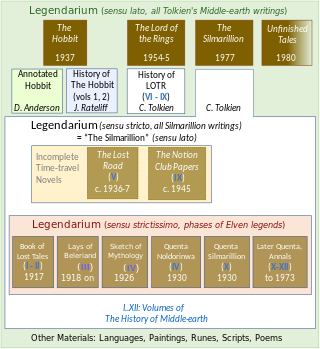Balrogs are a species of powerful demonic monsters in J. R. R. Tolkien's Middle-earth. One first appeared in print in his high-fantasy novel The Lord of the Rings, where the Company of the Ring encounter a Balrog known as Durin's Bane in the Mines of Moria. Balrogs appear also in Tolkien's The Silmarillion and his legendarium. Balrogs are tall and menacing beings who can shroud themselves in fire, darkness, and shadow. They are armed with fiery whips "of many thongs", and occasionally use long swords.
In the works of J. R. R. Tolkien, the Noldor are a kindred of Elves who migrate west to the blessed realm of Valinor from the continent of Middle-earth, splitting from other groups of Elves as they went. They then settle in the coastal region of Eldamar. The Dark Lord Morgoth murders their first leader, Finwë. The majority of the Noldor, led by Finwë's eldest son Fëanor, then return to Beleriand in the northwest of Middle-earth. This makes them the only group to return and then play a major role in Middle-earth's history; much of The Silmarillion is about their actions. They are the second clan of the Elves in both order and size, the other clans being the Vanyar and the Teleri.

Fëanor is a fictional character in J. R. R. Tolkien's The Silmarillion. He creates the Tengwar script, the palantír seeing-stones, and the three Silmarils, the skilfully forged jewels that give the book their name and theme, triggering division and destruction. He is the eldest son of Finwë, the King of the Noldor Elves, and his first wife Míriel.
Lúthien and Beren are characters in J. R. R. Tolkien's fantasy world Middle-earth. Lúthien is an elf, daughter of the elf-king Thingol and goddess-like Melian. Beren is a mortal man. The complex tale of their love for each other and the quest they are forced to embark upon is a story of triumph against overwhelming odds but ending in tragedy. It appears in The Silmarillion, the epic poem The Lay of Leithian, the Grey Annals section of The War of the Jewels, and in the texts collected in the 2017 book Beren and Lúthien. Their story is told to Frodo by Aragorn in The Lord of the Rings.

Elu Thingol or Elwë Singollo is a fictional character in J.R.R. Tolkien's Middle-earth legendarium. He appears in The Silmarillion, The Lays of Beleriand and The Children of Húrin and in numerous stories in The History of Middle-earth. The King of Doriath, King of the Sindar Elves, High-king and Lord of Beleriand, he is a major character in the First Age of Middle-earth and an essential part of the ancestral backgrounding of the romance between Aragorn and Arwen in The Lord of the Rings. Alone among the Elves, he married an angelic Maia, Melian.

Fingolfin is a character in J. R. R. Tolkien's legendarium, appearing in The Silmarillion. He was the son of Finwë, High King of the Noldor. He was threatened by his half-brother Fëanor, who held him in contempt for not being a pure-bred Noldor. Even so, when Fëanor stole ships and left Aman, Fingolfin chose to follow him back to Middle-earth, taking the dangerous route over the ice of the Helcaraxë. On arrival, he challenged the Dark Lord Morgoth at the gates of his fortress, Angband, but Morgoth stayed inside. When his son Fingon rescued Maedhros, son of Fëanor, Maedhros gratefully renounced his claim to kingship, and Fingolfin became High King of the Noldor. He was victorious at the battle of Dagor Aglareb, and there was peace for some 400 years until Morgoth broke out and destroyed Beleriand in the Dagor Bragollach. Fingolfin, receiving false news, rode alone to Angband and challenged Morgoth to single combat. He wounded Morgoth several times, but grew weary and was killed by the immortal Vala.
In J. R. R. Tolkien's legendarium, the Elves or Quendi are a sundered (divided) people. They awoke at Cuiviénen on the continent of Middle-earth, where they were divided into three tribes: Minyar, Tatyar and Nelyar. After some time, they were summoned by Oromë to live with the Valar in Valinor, on Aman. That summoning and the Great Journey that followed split the Elves into two main groups, which were never fully reunited.
Túrin Turambar is a fictional character in J. R. R. Tolkien's legendarium. Turambar and the Foalókë, begun in 1917, is the first appearance of Túrin in the legendarium. Túrin is a Man of the First Age of Middle-earth, whose family had been cursed by the Dark Lord Morgoth. While trying vainly to defy the curse, Túrin brings ruin across much of Beleriand, and upon himself and his sister Niënor. His title, "Turambar", means master of fate.
In J. R. R. Tolkien's Middle-earth, the Eagles or Great Eagles, are immense birds that are sapient and can speak. The Great Eagles resemble actual eagles, but are much larger. Thorondor is said to have been the greatest of all birds, with a wingspan of 30 fathoms. Elsewhere, the Eagles have varied in nature and size both within Tolkien's writings and in later adaptations.
Húrin is a fictional character in the Middle-earth legendarium of J. R. R. Tolkien. He is introduced in The Silmarillion as a hero of Men during the First Age, said to be the greatest warrior of both the Edain and all Men in Middle-earth. His actions, however, bring catastrophe and ruin to his family and to the people of Beleriand.

In J. R. R. Tolkien's legendarium, the history of Arda, also called the history of Middle-earth, began when the Ainur entered Arda, following the creation events in the Ainulindalë and long ages of labour throughout Eä, the fictional universe. Time from that point was measured using Valian Years, though the subsequent history of Arda was divided into three time periods using different years, known as the Years of the Lamps, the Years of the Trees, and the Years of the Sun. A separate, overlapping chronology divides the history into 'Ages of the Children of Ilúvatar'. The first such Age began with the Awakening of the Elves during the Years of the Trees and continued for the first six centuries of the Years of the Sun. All the subsequent Ages took place during the Years of the Sun. Most Middle-earth stories take place in the first three Ages of the Children of Ilúvatar.

The Children of Húrin is an epic fantasy novel which forms the completion of a tale by J. R. R. Tolkien. He wrote the original version of the story in the late 1910s, revising it several times later, but did not complete it before his death in 1973. His son, Christopher Tolkien, edited the manuscripts to form a consistent narrative, and published it in 2007 as an independent work. The book is illustrated by Alan Lee. The story is one of the three "Great Tales" set in the First Age of Tolkien's Middle-earth, the other two being Beren and Lúthien and The Fall of Gondolin.

Tolkien's legendarium is the body of J. R. R. Tolkien's mythopoeic writing, unpublished in his lifetime, that forms the background to his The Lord of the Rings, and which his son Christopher summarized in his compilation of The Silmarillion and documented in his 12-volume series The History of Middle-earth. The legendarium's origins reach back to 1914, when Tolkien began writing poems and story sketches, drawing maps, and inventing languages and names as a private project to create a mythology for England. The earliest story, "The Voyage of Earendel, the Evening Star", is from 1914; he revised and rewrote the legendarium stories for most of his adult life.
The Maiar are a fictional class of beings from J. R. R. Tolkien's high fantasy legendarium. Supernatural and angelic, they are "lesser Ainur" who entered the cosmos of Eä in the beginning of time. The name Maiar is in the Quenya tongue from the Elvish root maya- "excellent, admirable".
In J. R. R. Tolkien's writings, Elves are the first fictional race to appear in Middle-earth. Unlike Men and Dwarves, Elves do not die of disease or old age. Should they die in battle or of grief, their souls go to the Halls of Mandos in Aman. After a long life in Middle-earth, Elves yearn for the Earthly Paradise of Valinor, and can sail there from the Grey Havens. They feature in The Hobbit and The Lord of the Rings. Their history is described in detail in The Silmarillion.
Galadriel is a character created by J. R. R. Tolkien in his Middle-earth writings. She appears in The Lord of the Rings, The Silmarillion, and Unfinished Tales.
Morgoth Bauglir is a character, one of the godlike Valar and the primary antagonist of Tolkien's legendarium, the mythic epic published in parts as The Silmarillion, The Children of Húrin, Beren and Lúthien, and The Fall of Gondolin.
The Silmarils are three fictional brilliant jewels in J. R. R. Tolkien's legendarium, made by the Elf Fëanor, capturing the unmarred light of the Two Trees of Valinor. The Silmarils play a central role in Tolkien's book The Silmarillion, which tells of the creation of Eä and the beginning of Elves, Dwarves and Men.

The Silmarillion is a book consisting of a collection of myths and stories in varying styles by the English writer J. R. R. Tolkien. It was edited, partly written, and published posthumously by his son Christopher Tolkien in 1977, assisted by Guy Gavriel Kay, who became a fantasy author. It tells of Eä, a fictional universe that includes the Blessed Realm of Valinor, the ill-fated region of Beleriand, the island of Númenor, and the continent of Middle-earth, where Tolkien's most popular works—The Hobbit and The Lord of the Rings—are set. After the success of The Hobbit, Tolkien's publisher, Stanley Unwin, requested a sequel, and Tolkien offered a draft of the writings that would later become The Silmarillion. Unwin rejected this proposal, calling the draft obscure and "too Celtic", so Tolkien began working on a new story that eventually became The Lord of the Rings.









